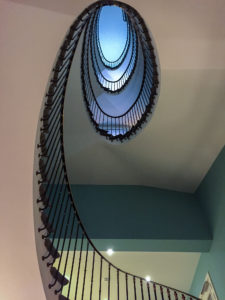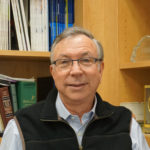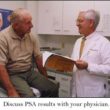The Room Where It Happened

By Connie Lippowitsch
Ron Chernow wrote the biography of Alexander Hamilton that inspired Lin-Manuel Miranda’s musical, Hamilton. “The Room Where It Happened,” a song from the musical, describes how the founding fathers wanted to be part of the American Revolution. Here, we shine the light on two founding fathers in prostate cancer research who laid the groundwork for exciting advances for prostate cancer patients that have recently emerged. They were truly “… in the Room Where It Happened.”
This is an exciting time in prostate cancer research, but it did not happen overnight. In the past few months, the FDA has approved two prostate-specific membrane antigen (PSMA)–targeted PET scan imaging agents for prostate cancer: 68Ga-PSMA-11 or Gallium 68 and 18F-DCFPyl or Pyl). Both radioactive tracer molecules bind to PSMA so that doctors can use them to “light up” areas of cancer on PET scans. Both agents perform dramatically better than conventional imaging tools (bone, CT or MR scans) in the prostate cancer field in facilitating early detection and visualization of the disease in patients.
Also, promising results were just released from a clinical trial for a revolutionary new class of therapy that targets and kills prostate cancer cells in the body: 177Lu-PSMA-617. This is important because metastatic prostate cancer that may initially respond to hormone therapy and other medications may in time overcome the drugs by developing adaptations that allow it to thrive. 177Lu-PSMA-617 is made up of a small chemical that binds to PSMA (PSMA-617) and it has the radioactive particle, 177Lu, attached to it. When 177Lu-PSMA-617 is injected into a patient, it circulates throughout the body and binds to any cells where PSMA is present. When it binds a prostate cancer cell, the radioactive 177Lu-PSMA-617 is taken into the cancer cell where it delivers a high dose of radiation that kills the cancer but causes little damage to surrounding tissue because the radiation does not extend far beyond the tumor.
The Founding Fathers
Like many groundbreaking discoveries, this work has been a long time in the making — decades in fact. Warren W.D. Heston, Ph.D. and Neil H. Bander, M.D. are two of the “founding fathers” who have been instrumental in this groundbreaking work identifying and seeing the potential beneficial impact of PSMA.

Early on in his career, Dr. Heston was a post-doctoral fellow in pharmacology, studying under his mentor, Dr. Donald S. Coffey at Johns Hopkins School of Medicine, whose research labs were located in the Department of Urology. Urology residents were required to complete a year of research with Dr. Coffey, and Dr. Heston fondly recalls talking with the urology residents about science, medicine, and the issues they faced in dealing with prostate cancer. Dr. Catalona was one of these residents when Dr. Heston was a post-doc student. Dr. Heston was interested in antibody-targeted therapies, and prostate cancer research soon became his life’s work.
Drs. Heston and Catalona crossed paths again at Washington University before Dr. Heston began working at New York’s Memorial Sloan Kettering Cancer Center as the Director of Urological Research. It was there in 1993 that Dr. Heston and his team were the first to clone and name PSMA, a protein molecule expressed by more than 80-90% of prostate cancer tumors. During this period, Dr. Heston’s group did biologic characterization of PSMA, establishing that it should be an outstanding target for imaging and therapy in patients with prostate cancer. In fact, in a paper published in Cancer Research in 1993, Dr. Heston predicted its exact usefulness in the clinic today.

Dr. Bander got involved in PSMA research after he learned that Dr. George Wright from Eastern Virginia
Medical School found that the original antibody used to identify the PSMA molecule targeted a portion of the PSMA molecule that was “hidden” on the inside of the prostate cancer cell. He realized that an antibody that would bind to the portion of PSMA on the outside surface of the cancer cell would be more useful for clinical practice.
Opening Doors that were Previously Closed

The Bander and Heston research teams spent years investigating PSMA. They found that the more aggressive and dangerous prostate cancer cells are, the more PSMA they expressed on their surfaces. They also found that when patients are treated with hormones, the amount of PSMA on the tumor cell surface increases up to 5-10-fold, effectively enlarging the “bullseye” on the target. Dr. Bander’s team found that when PSMA-targeted agents bind to PSMA, the binding agent and any attached payload, gets internalized into the prostate cancer cell, suggesting that it may be possible to develop chemotherapeutic agents that impact only the cancer cells. When Bander’s team looked at other types of cancers, they also found that the blood vessels feeding those tumors also expressed PSMA whereas normal blood vessels were PSMA-negative. These findings were independently and simultaneously documented by Dr. Heston’s group, suggesting that a PSMA-targeted drug could potentially attack the blood supply to other cancers such as breast, kidney, brain and other cancers.
In 1997, Dr. Bander and his colleagues reported in Cancer Research their development of the first antibodies that bind to a part of the PSMA molecule on the exterior of the cell; these were the first antibodies that could bind to living prostate cancer cells. As their goal was to develop this into a therapeutic, they “humanized” the antibody by genetically re-engineering it from a mouse-derived antibody so the human body would not recognize it as a foreign protein and thus, it would be useful for more patients.
In the United States, formal experimental clinical trials are always required before new treatments are approved for patient use. Some other countries permit new approaches with patients when no other “approved” therapy has been effective — so-called “compassionate use.” Beginning around 2015, German researchers tested PSMA binding agents such as 177Lu-PSMA-617 in some patients and found that the treatment was well tolerated and induced a remission of the cancer. A similar Australian trial, published in 2018 in Lancet Oncology confirmed the German results.
Unprecedented Financial Power
In the U.S., clinical trials with the humanized antibody were launched in 2000 – a time when no pharmaceutical companies were interested in developing radioactive pharmaceutical treatments. Only recently has the field of radiopharmaceutical imaging and therapeutics flourished. Thus, the earlier groundbreaking work by Heston, Bander, and others laid the foundation for the amazing progress occurring in the field today.
“Something that’s Gonna Outlive Me”

Dr. Heston has now retired from full-time research, although remaining active in teaching, his interest and excitement remains unabated. In effect, he has returned to the early years of his career and the enjoyment he received from his discussions with urology residents. He is gratified that his seminal PSMA research will improve the lives of countless cancer patients.
Dr. Bander was always convinced that his ideas about therapeutics and imaging would work. He has made the difficult decision to stop performing surgery and eventually to stop seeing patients all together, to dedicate himself exclusively to research. He believes that, while he could possibly help hundreds or thousands of patients through direct patient care, he could potentially reach many more over time through his research efforts. He laments that the progress was not easier, less frustrating, and taken so long but is ecstatic that it is happening now.
Today Dr. Bander’s lab continues to drive the field forward studying another radioactive payload called 225actinium, an even more potent and precise isotope than 177lutetium. 225Ac is more than 1,000-fold more potent than 177Lu and it focuses its energy over only four cell diameters resulting in less damage to surrounding cells and is harder for cancer cells to overcome. Also, Bander’s research group at Weill-Cornell Medicine and NY-Presbyterian Hospital is just now launching a trial combining both 177lutetium and 225actinium—another first. Dr. Heston wants patients to know there is hope for more breakthroughs, and says Dr. Bander, “We are only now scratching the surface of what is going to happen with prostate cancer treatments in the future!”
















